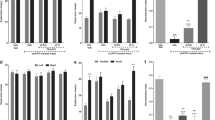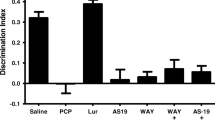Abstract
Rational
Atypical antipsychotic drugs (APDs) such as clozapine, olanzapine, quetiapine, risperidone, and ziprasidone are serotonin (5-HT)2A antagonists and relatively weaker dopamine (DA) D2 antagonists, with variable 5-HT2C antagonist properties. The ability of atypical APDs to preferentially increase DA release in the cortex compared to the limbic system is believed to be due in part to their antagonism of 5-HT2A and D2 receptors and believed to contribute to their beneficial effects on cognition, negative, and psychotic symptoms. Previous studies from this laboratory using microdialysis have shown that pretreatment of the 5-HT2A antagonist M100907 with the typical APD and D2 antagonist haloperidol produced an increase in the medial prefrontal cortex (mPFC), but not in the nucleus accumbens (NAC), DA release. However, pretreatment with the 5-HT2A/2C receptor antagonist SR46349-B with haloperidol increased both mPFC and NAC DA release, suggesting that both 5-HT2A and 5-HT2C properties may be important for atypical APD effects.
Objective
The purpose of this study was to examine the effects of a novel putative atypical APD ACP-103 on mPFC and NAC DA release using in vivo microdialysis in freely moving rats that are awake. ACP-103 is an inverse agonist at both 5-HT2A and 5-HT2C receptors and has intermediate affinities for 5-HT2C receptors relative to their affinities for 5-HT2A receptors compared to M100907 and SR46349-B. In addition, the effects of ACP-103 were compared to M100907 and SR46349-B, and ACP-103 was also coadministered with haloperidol.
Results
ACP-103 10.0 mg/kg, but not 3.0 mg/kg, increased DA release in the mPFC, while neither dose increased DA release in the NAC. Like M100907, ACP-103 (3.0 mg/kg) potentiated 0.1 mg/kg haloperidol-induced DA release in the mPFC while inhibiting that in the NAC. However, ACP-103 (3.0 mg/kg), similar to SR46349-B, potentiated a high dose of haloperidol (1.0 mg/kg)-induced DA release in both regions. The potent 5-HT2C antagonist SB242084 1.0 mg/kg significantly potentiated 0.1 mg/kg haloperidol-induced DA release in both the mPFC and NAC. However, SB242084, at 0.2 mg/kg, significantly potentiated DA release only in the NAC. Moreover, SB242084 0.2 mg/kg potentiated DA release in the NAC produced by the combination treatment of 3 mg/kg ACP-103 and 0.1 mg/kg haloperidol.
Conclusion
These data suggest that the relative extent of 5-HT2A and 5-HT2C antagonism, as well as the extent of D2 receptor blockade, has a critical influence on DA release in the mPFC and NAC and may be a determining factor in the action of this class of atypical APDs on these two potentially clinically relevant parameters.






Similar content being viewed by others
References
Abramowski D, Rigo M, Duc D, Hoyer D, Staufenbiel M (1995) Localization of the 5-hydroxytryptamine2C receptor protein in human and rat brain using specific antisera. Neuropharmacology 34:1635–1645
Acadia Pharmaceuticals Inc. (2005) Acadia Pharmaceuticals announces encouraging interim results from ongoing phase II trial of ACP-103 for treatment-induced psychosis in patients with Parkinson's disease. PRNewswire-FirstCall, NY
Andersson JL, Nomikos GG, Marcus M, Hertel P, Mathe JM, Svensson TH (1995) Ritanserin potentiates the stimulatory effects of raclopride on neuronal activity and dopamine release selectivity in the mesolimbic dopaminergic system. Naunyn-Schmiedeberg's Arch Pharmacol 352:374–385
Bonaccorso S, Meltzer H, Li Z, Dai J, Alboszta A, Ichikawa J (2002) SR46349-B, a 5-HT(2A/2C) receptor antagonist, potentiates haloperidol-induced dopamine release in rat medial prefrontal cortex and nucleus accumbens. Neuropsychopharmacology 27:430–441
Canton H, Verriele L, Colpaert FC (1990) Binding of typical and atypical antipsychotics to 5-HT1C and 5-HT2 sites—clozapine potently interacts with 5-HT1C sites. Eur J Pharmacol 191:93–96
Clemett DA, Punhani T, Duxon MS, Blackburn TP, Fone KCF (2000) Immunohistochemical localisation of the 5-HT2C receptor protein in the rat CNS. Neuropharmacology 39:123–132
De Deurwaerdere P, Navailles S, Berg KA, Clarke WP, Spampinato U (2004) Constitutive activity of the serotonin2C receptor inhibits in vivo dopamine release in the rat striatum and nucleus accumbens. J Neurosci 24:3235–3241
Di Giovanni G, De Deurwaerdere P, Di Mascio M, Di Matteo V, Esposito E, Spampinato U (1999) Selective blockade of serotonin2C/2B receptors enhances mesolimbic and mesostriatal dopaminergic function: a combined in vivo electrophysiological and microdialysis study. Neuroscience 91:587–597
Di Matteo V, Di Giovanni G, Di Mascio M, Esposito E (1999) SB242084, a selective serotonin2C receptor antagonist, increases dopaminergic transmission in the mesolimbic system. Neuropharmacology 38:1195–1205
Eberle-Wang K, Mikeladze Z, Uryu K, Chesselet MF (1997) Pattern of expression of the serotonin2C receptor messenger RNA in the basal ganglia of adult rats. J Comp Neurol 384:233–247
Farde L, Nordstrom AL, Wiesel FA, Pauli S, Halldin C, Sedvall G (1992) Positron emission tomographic analysis of central D1 and D2 dopamine receptor occupancy in patients treated with classical neuroleptics and clozapine. Relation to extrapyramidal side effects. Arch Gen Psychiatry 49:538–544
Gobert A, Rivet JM, Lejeune F, Newman-Tancredi A, Adhumeau-Auclair A, Nicolas J, Cistarelli L, Melon C, Millan MJ (2000) Serotonin2C receptors tonically suppress the activity of mesocortical dopaminergic and adrenergic, but not serotonergic, pathways: a combined dialysis and electrophysiological analysis in the rat. Synapse 36:205–221
Herrick-Davis K, Grinde E, Teitler M (2000) Inverse agonist activity of atypical antipsychotic drugs at human 5-hydroxytryptamine2C receptors. J Pharmacol Exp Ther 295:226–232
Hutson PH, Barton CL, Jay M, Blurton P, Burkamp F, Clarkson R, Bristow LJ (2000) Activation of mesolimbic dopamine function by phencyclidine is enhanced by 5-HT2C/2B receptor antagonists: neurochemical and behavioural studies. Neuropharmacology 39:2318–2328
Ichikawa J, Meltzer HY (1999) Relationship between dopaminergic and serotonergic neuronal activity in the frontal cortex and the action of typical and atypical antipsychotic drugs. Eur Arch Psychiatry Clin Neurosci 249(Suppl 4):90–98
Ichikawa J, Ishii H, Bonaccorso S, Fowler WL, O'Laughlin IA, Meltzer HY (2001) 5-HT(2A) and D(2) receptor blockade increases cortical DA release via 5-HT(1A) receptor activation: a possible mechanism of atypical antipsychotic-induced cortical dopamine release. J Neurochem 76:1521–1531
Kennett GA, Wood MD, Bright F, Trail B, Riley G, Holland V, Avenell KY, Stean T, Upton N, Bromidge S, Forbes IT, Brown AM, Middlemiss DN, Blackburn TP (1997) SB 242084, a selective and brain penetrant 5-HT2C receptor antagonist. Neuropharmacology 36:609–620
Kuroki T, Meltzer HY, Icikawa J (1999) Effects of antipsychotic drugs on extracellular dopamine levels in rat medial prefrontal cortex and nucleus accumbens. J Pharmacol Exp Ther 288:774–781
Li Z, Ichikawa J, Dai J, Meltzer HY (2004) Aripiprazole, a novel antipsychotic drug, preferentially increases dopamine release in the prefrontal cortex and hippocampus in rat brain. Eur J Pharmacol 493:75–83
Liégeois JF, Ichikawa J, Meltzer HY (2002) 5-HT2A receptor antagonism potentates haloperidol-induced dopamine release in rat medial prefrontal cortex and inhibits that in the nucleus accumbens in a dose-dependent manner. Brain Res 947:157–162
Lucas G, De Deurwaerdere P, Caccia S, Spampinato U (2000) The effect of serotonergic agents on haloperidol-induced striatal dopamine release in vivo: opposite role of 5-HT(2A) and 5-HT(2C) receptor subtypes and significance of the haloperidol dose used. Neuropharmacology 39:1053–1063
Meltzer HY, McGurk SR (1999) The effects of clozapine, risperidone, and olanzapine on cognition in schizophrenia. Schizophr Bull 25:233–256
Meltzer HY, Matsubara S, Lee JC (1989) Classification of typical and atypical antipsychotic drugs on the basis of dopamine D-1, D-2 and serotonin2 pKi values. J Pharmacol Exp Ther 251:238–246
Meltzer HY, Arvanitis L, Bauer D, Rein W, Meta-Trial Study Group (2004) Placebo-controlled evaluation of four novel compounds for the treatment of schizophrenia and schizoaffective disorder. Am J Psychiatry 161:975–984
Millan MJ, Dekeyne A, Gobert A (1998) Serotonin (5-HT)2C receptors tonically inhibit dopamine (DA) and noradrenaline (NA), but not 5-HT, release in the frontal cortex in vivo. Neuropharmacology 37:953–955
Moghaddam B, Bunney BS (1990) Acute effects of typical and atypical antipsychotic drugs on the release of dopamine from prefrontal cortex, nucleus accumbens, and striatum of the rat: an in vivo microdialysis study. J Neurochem 54:1755–1760
Navailles S, De Deurwaerdere P, Porras G, Spampinato U (2004) In vivo evidence that 5-HT2C receptor antagonist but not agonist modulates cocaine-induced dopamine outflow in the rat nucleus accumbens and striatum. Neuropsychopharmacology 29:319–326
Paxinos G, Watson C (1998) The rat brain in stereotaxic coordinates. Academic, New York
Pehek EA (1996) Local infusion of the serotonin antagonists ritanserin or ICS 205,930 increases in vivo dopamine release in the rat medial prefrontal cortex. Synapse 24:12–18
Pompeiano M, Palacios JM, Mengod G (1994) Distribution of the serotonin 5-HT2 receptor family mRNAs: comparison between 5-HT2A and 5-HT2C receptors. Brain Res Mol Brain Res 23:163–178
Porras G, Di Matteo V, Fracasso C, Lucas G, De Deurwaerdere P, Caccia S, Esposito E, Spampinato U (2002) 5-HT2A and 5-HT2C/2B receptor subtypes modulate dopamine release induced in vivo by amphetamine and morphine in both the rat nucleus accumbens and striatum. Neuropsychopharmacology 26:311–324
Pozzi L, Acconcia S, Ceglia I, Invernizzi RW, Samanin R (2002) Stimulation of 5-hydroxytryptamine (5-HT(2C)) receptors in the ventrotegmental area inhibits stress-induced but not basal dopamine release in the rat prefrontal cortex. J Neurochem 82:93–100
Prisco S, Pagannone S, Esposito E (1994) Serotonin–dopamine interaction in the rat ventral tegmental area: an electrophysiological study in vivo. J Pharmacol Exp Ther 271:83–90
Roth BL, Ciaranello RD, Meltzer HY (1992) Binding of typical and atypical antipsychotic agents to transiently expressed 5-HT1C receptors. J Pharmacol Exp Ther 260:1361–1365
Schotte A, Janssen PF, Gommeren W, Luyten WH, Van Gompel P, Lesage AS, De Loore K, Leysen JE (1996) Risperidone compared with new and reference antipsychotic drugs: in vitro and in vivo receptor binding. Psychopharmacology (Berl) 124:57–73
Stockmeier CA, DiCarlo JJ, Zhang Y, Thompson P, Meltzer HY (1993) Characterization of typical and atypical antipsychotic drugs based on in vivo occupancy of serotonin2 and dopamine2 receptors. J Pharmacol Exp Ther 266:1374–1384
Vanover KE, Harvey SC, Son T, Bradley SR, Kold H, Makhay M, Veinbergs I, Spalding TA, Weiner DM, Andersson CM, Tolf BR, Brann MR, Hacksell U, Davis RE (2004) Pharmacological characterization of AC-90179 [2-(4-methoxyphenyl)-N-(4-methyl-benzyl)-N-(1-methyl-piperidin-4-yl)-acetamide hydrochloride]: a selective serotonin 2A receptor inverse agonist. J Pharmacol Exp Ther 310(3):943–951. DOI 10.1124/jpet.104.066688
Weiner DM, Burstein ES, Nash N, Croston GE, Currier EA, Vanover KE, Harvey SC, Donohue E, Hansen HC, Andersson CM, Spalding TA, Gibson DF, Krebs-Thomson K, Powell SB, Geyer MA, Hacksell U, Brann MR (2001) 5-hydroxytryptamine2A receptor inverse agonists as antipsychotics. J Pharmacol Exp Ther 299:268–276
Willins DL, Meltzer HY (1998) Serotonin 5-HT2C agonists selectively inhibit morphine-induced dopamine efflux in the nucleus accumbens. Brain Res 781:291–299
Zhang W, Bymaster FP (1999) The in vivo effects of olanzapine and other antipsychotic agents on receptor occupancy and antagonism of dopamine D1, D2, D3, 5HT2A and muscarinic receptors. Psychopharmacology (Berl) 141:267–278
Acknowledgements
Supported in part by a grant from Acadia Pharmaceuticals Inc.
Author information
Authors and Affiliations
Corresponding author
Rights and permissions
About this article
Cite this article
Li, Z., Ichikawa, J., Huang, M. et al. ACP-103, a 5-HT2A/2C inverse agonist, potentiates haloperidol-induced dopamine release in rat medial prefrontal cortex and nucleus accumbens. Psychopharmacology 183, 144–153 (2005). https://doi.org/10.1007/s00213-005-0170-9
Received:
Accepted:
Published:
Issue Date:
DOI: https://doi.org/10.1007/s00213-005-0170-9




